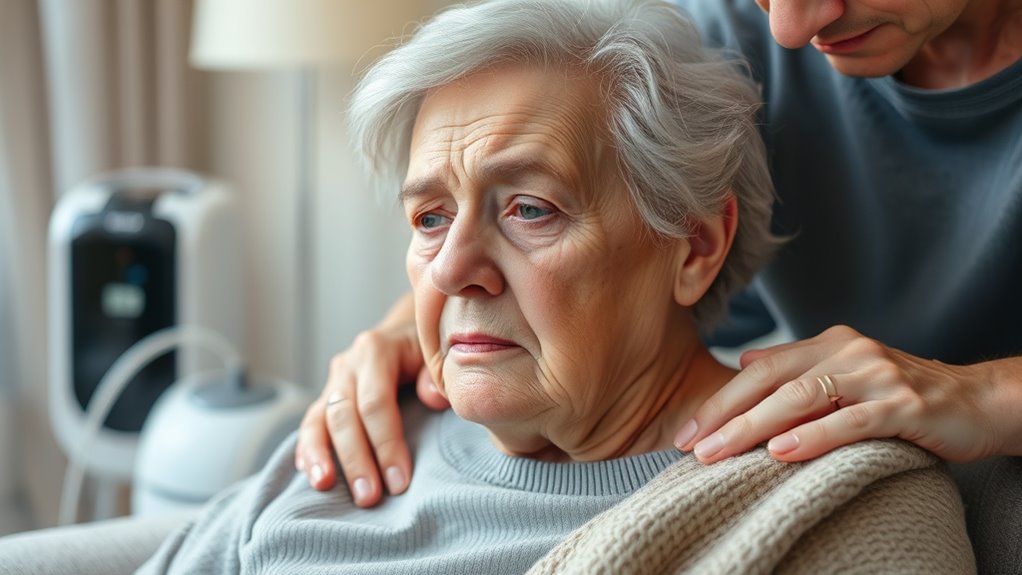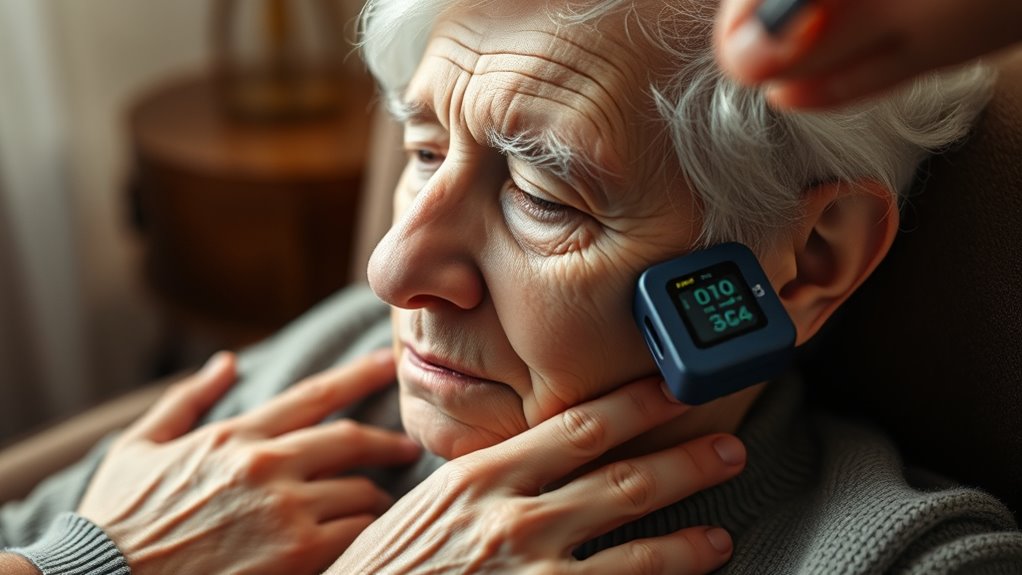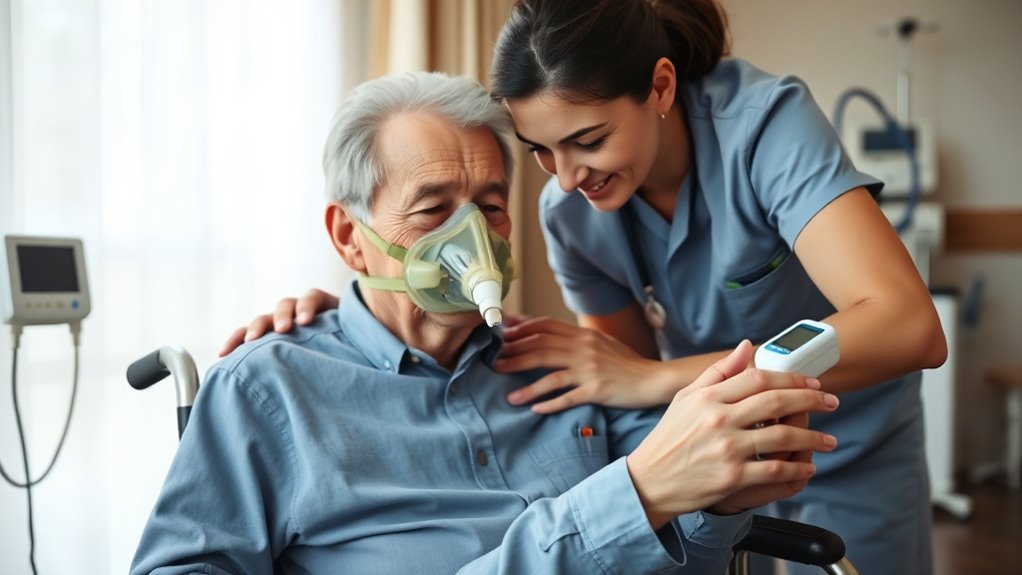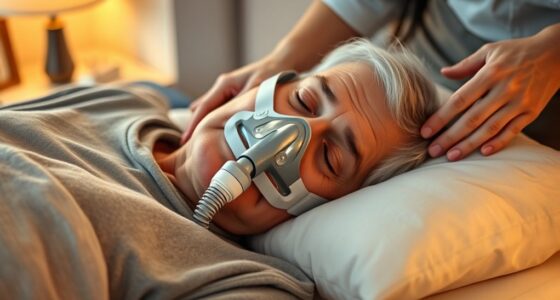Recognizing and relieving dyspnea in Alzheimer’s patients involves observing subtle signs like rapid breathing, facial expressions, or restlessness, since communication is often impaired. You should monitor their breathing patterns, posture, and behavior closely, and create a calm environment to reduce distress. Non-verbal cues such as facial expressions, body language, or vocalizations help you understand their discomfort. Learning effective ways to assess and address these symptoms can greatly improve their comfort and safety. Keep exploring to discover practical strategies you can use.
Key Takeaways
- Observe nonverbal cues such as facial expressions, posture, and agitation to detect dyspnea in non-communicative Alzheimer’s patients.
- Monitor breathing patterns regularly, noting rapid, shallow, or irregular respiration and physical signs like nasal flaring or bluish lips.
- Create a calm environment and use simple signals or visual aids to help patients communicate discomfort effectively.
- Implement non-pharmacological strategies such as elevating the head, encouraging relaxation, and ensuring proper ventilation to relieve dyspnea.
- Collaborate with healthcare providers for appropriate medical interventions like oxygen therapy, bronchodilators, or corticosteroids.
Understanding Dyspnea and Its Impact on Alzheimer’s Patients

Dyspnea, or difficulty breathing, is a common yet often overlooked symptom in Alzheimer’s patients. It can profoundly affect their quality of life, making daily activities challenging and increasing their anxiety. You might notice your loved one appearing short of breath after minimal exertion or during rest, which can be confusing and concerning. Understanding dyspnea involves recognizing that it’s not just a physical issue but also impacts mental well-being, leading to frustration or agitation. This symptom may stem from underlying health problems like heart or lung disease, which often go unnoticed in Alzheimer’s patients. Addressing dyspnea early is crucial, as it can prevent further complications and improve their comfort. Using appropriate comfort and support solutions can help alleviate some of their distress. Recognizing its impact helps you advocate for appropriate medical evaluation and intervention, especially considering that contrast ratio plays a role in how symptoms are perceived visually and physically. Additionally, advances in medical technology may assist in early detection and management of underlying causes contributing to dyspnea. Being aware of the spiritual connections associated with health symptoms can also provide additional insights into holistic care approaches.
Common Signs and Symptoms of Shortness of Breath in Cognitive Decline

Recognizing the signs of shortness of breath in individuals with cognitive decline can be challenging, as they may not always communicate their discomfort clearly. Instead, look for subtle cues such as increased restlessness, pacing, or facial expressions that suggest distress. Watch for rapid or shallow breathing, flared nostrils, or a bluish tint around the lips, which indicate oxygen deprivation. They might also become more fatigued or appear unusually anxious. Changes in posture, like leaning forward or clutching the chest, can signal difficulty breathing. Additionally, decreased activity levels or reluctance to engage in usual activities may be signs of underlying dyspnea. Being attentive to these signs helps you identify discomfort early and seek appropriate support for your loved one. Monitoring aquatic exercise opportunities can also help improve overall respiratory function and comfort. Incorporating breathing techniques and respiratory exercises can assist in managing symptoms and enhancing respiratory efficiency. Recognizing these subtle indicators early aligns with the importance of consistent messaging in caregiving, ensuring timely intervention and improved quality of life.
Challenges in Detecting Dyspnea in Individuals With Dementia

Detecting dyspnea in individuals with dementia is challenging because they often can’t communicate their discomfort clearly. You need to watch for nonverbal cues like facial expressions, posture changes, or increased agitation. Recognizing these signs requires careful observation and understanding of subtle behavioral shifts.
Communication Barriers
Because individuals with dementia often experience communication difficulties, identifying dyspnea becomes particularly challenging. They may struggle to express discomfort or describe breathing issues, leaving you to interpret subtle cues. This can lead to delayed diagnosis and treatment. To navigate these barriers, consider these strategies:
- Pay close attention to changes in speech patterns or the way they express themselves.
- Observe for any signs of frustration or agitation that may indicate breathing problems.
- Look for discrepancies between their verbal responses and physical behavior.
- Engage caregivers to gather insights about any unspoken concerns or previous episodes.
Understanding these communication barriers helps you become more proactive in recognizing early signs of dyspnea, even when clear communication isn’t possible.
Nonverbal Indicators
Nonverbal indicators are often the only clues that someone with dementia is experiencing dyspnea, making it essential to observe their physical cues carefully. Look for signs like increased restlessness, facial grimacing, or a strained expression. You might notice rapid or shallow breathing, flaring nostrils, or a change in posture, such as leaning forward or clutching the chest. Changes in vocalizations, like groaning or sighing, can also signal discomfort. Watch for decreased activity levels or refusal to eat and drink, which may indicate difficulty breathing. Since these patients can’t verbalize their symptoms, your attentive observation is crucial. Recognizing these subtle cues early allows you to intervene and provide relief before the situation worsens.
Factors Contributing to Respiratory Difficulties in Alzheimer’s Disease

Several factors contribute to respiratory difficulties in Alzheimer’s patients, often compounding their health challenges. First, cognitive decline can impair their ability to recognize symptoms or communicate discomfort, delaying treatment. Second, decreased mobility increases the risk of lung infections like pneumonia due to reduced coughing and deep breathing. Third, sensory changes may cause choking hazards or aspiration during eating or drinking. Fourth, comorbid conditions such as chronic obstructive pulmonary disease (COPD) or heart disease can weaken respiratory function. These factors often work together, making it harder to detect and address respiratory issues early. Understanding these contributors helps you better anticipate risks and support your loved one’s respiratory health effectively.
Techniques for Observing and Assessing Respiratory Distress

To effectively assess respiratory distress in Alzheimer’s patients, you need to recognize key signs of difficulty breathing. Monitoring their respiratory rate helps identify when their breathing becomes abnormal. Being attentive to these cues allows for timely intervention and better patient care.
Recognizing Breathing Signs
Recognizing breathing signs in Alzheimer’s patients requires careful observation of their physical cues and breathing patterns. You should watch for subtle changes that may indicate distress. Pay attention to these key signs:
- Increased respiratory rate or irregular breathing patterns
- Use of accessory muscles, like neck or chest muscles, to breathe
- Nasal flaring or visible effort during inhalation and exhalation
- Changes in facial expression, such as grimacing or furrowed brows
Being attentive helps you detect early signs of discomfort. Avoid rushing or making assumptions; instead, observe calmly and consistently. Noticing these signs early allows you to intervene promptly, potentially easing their breathing difficulties before they worsen. Your careful observation is essential in providing timely support and comfort.
Monitoring Respiratory Rate
Monitoring respiratory rate is a vital step in evaluating breathing health in Alzheimer’s patients. To do this effectively, find a quiet moment when your patient is calm and relaxed. Count their breaths for a full 60 seconds, observing the rise and fall of their chest. Pay attention to any irregularities, such as rapid or slow breathing, or pauses. It’s helpful to sit or stand in front of them, ensuring their abdomen and chest are visible. Keep a record of your observations, noting the rate and any unusual patterns. Regular monitoring allows you to detect early signs of distress. If you notice irregularities or increased difficulty breathing, consult a healthcare professional promptly. Consistent assessment helps you intervene early and provide relief to your loved one.
Strategies for Communicating About Discomfort With Nonverbal Patients

Communicating discomfort in nonverbal Alzheimer’s patients requires careful observation and tailored strategies. Pay attention to physical cues like facial expressions, body language, and vocalizations, which often signal distress. Use simple, consistent gestures or signals that the patient can learn and recognize. Establish a calm environment to reduce anxiety and facilitate communication. Encourage caregivers to document any signs of discomfort, creating a pattern over time. Additionally, consider employing tools like visual aids or communication boards to help patients express their needs more clearly. Remember, patience and attentiveness are key.
- Observe facial expressions and body language for signs of pain or distress
- Use simple gestures or signals consistently
- Create a calm, familiar environment
- Utilize visual aids to assist communication
Medical Interventions and Treatments for Managing Dyspnea

Managing dyspnea in Alzheimer’s patients often involves a combination of medical interventions and treatments tailored to the individual’s needs. You might start with medications like opioids, which can reduce the sensation of breathlessness without depressing overall respiration. Bronchodilators, such as inhalers or nebulizers, help open airways if respiratory issues like COPD are involved. Oxygen therapy may be prescribed if blood oxygen levels are low, providing immediate relief. Additionally, you may consider corticosteroids to reduce airway inflammation or antibiotics if an infection is present. It’s crucial to monitor your loved one’s response carefully and adjust treatments accordingly. Always work closely with healthcare professionals to ensure interventions are safe and appropriate, especially considering the complexities of Alzheimer’s disease and other comorbidities.
Non-Pharmacological Approaches to Easing Breathing Difficulties

While medical treatments play a vital role in alleviating dyspnea in Alzheimer’s patients, non-pharmacological strategies can also provide significant relief and improve comfort. You can help ease breathing difficulties through simple, supportive techniques.
- Use positioning: Elevate the head of the bed or encourage sitting upright to reduce lung pressure.
- Promote relaxation techniques: Deep breathing or guided imagery can calm anxiety that worsens breathlessness.
- Maintain a comfortable environment: Keep the room cool, well-ventilated, and free of irritants like smoke or strong odors.
- Encourage pacing and rest periods: Help your loved one avoid exertion that can trigger dyspnea, allowing for gradual activity with breaks.
- Be aware of the dog names that might comfort your loved one, as familiar and soothing names can help reduce anxiety and promote relaxation.
- Understanding resources and tools available can empower caregivers to implement effective strategies and seek additional support when needed.
Supporting Caregivers: Tips for Providing Comfort and Ensuring Safety

Caring for a loved one with Alzheimer’s and dyspnea can be challenging, but your support is essential for their comfort and safety. Stay calm and patient, speaking softly and reassuring them during episodes. Keep the environment safe by removing tripping hazards and ensuring proper ventilation. Use the following table to remember key safety tips:
| Tip | Action | Benefit |
|---|---|---|
| Monitor breathing | Observe for distress signs | Early intervention |
| Maintain upright position | Elevate head when resting | Eases breathing |
| Keep emergency contacts | Have phone accessible | Quick help in emergencies |
Frequently Asked Questions
How Can I Differentiate Between Normal Aging and Dyspnea in Alzheimer’S Patients?
You might wonder how to tell normal aging from dyspnea in Alzheimer’s patients. Watch for signs like increased breathing rate, shortness of breath during activity, or fatigue beyond typical age-related changes. Unlike normal aging, dyspnea often causes visible discomfort, wheezing, or chest tightness. Pay attention to changes in breathing patterns, and if you notice these, consult a healthcare professional promptly to guarantee proper assessment and care.
Are There Specific Environmental Modifications to Reduce Respiratory Distress?
Did you know that nearly 60% of respiratory distress cases improve with simple environmental changes? To reduce distress, keep the environment calm, clutter-free, and well-ventilated. Use soft lighting and minimize noise to prevent overstimulation. Confirm easy access to fresh air and maintain a comfortable temperature. These modifications help Alzheimer’s patients breathe easier by reducing triggers that can worsen dyspnea.
What Are the Long-Term Effects of Untreated Dyspnea in Dementia Patients?
If you ignore prolonged dyspnea in dementia patients, you risk worsening their health profoundly. Untreated, it can lead to decreased mobility, social withdrawal, and a decline in cognitive function. Over time, it may cause respiratory failure or even death. You should monitor symptoms closely and seek prompt medical intervention to prevent these serious long-term effects, ensuring your loved ones stay comfortable and safe.
Can Dietary Changes Help Alleviate Breathing Difficulties in Alzheimer’S Disease?
Did you know that proper nutrition can improve breathing in Alzheimer’s patients? Dietary changes, like reducing salt intake and ensuring balanced meals, may lessen fluid retention and inflammation that worsen dyspnea. By focusing on nutrient-rich foods and avoiding irritants, you can help support respiratory health. While diet alone isn’t a cure, small adjustments can make breathing easier, enhancing comfort and quality of life for your loved one.
When Should I Seek Emergency Medical Help for a Patient Experiencing Dyspnea?
If your patient is experiencing severe shortness of breath, turns blue, or can’t speak or breathe comfortably, seek emergency help immediately. Also, if they show signs of chest pain, fainting, or confusion, don’t delay. Call emergency services right away. It’s better to be cautious, especially if symptoms worsen quickly or don’t improve with basic measures. Prompt action can prevent serious complications and guarantee they receive the care they need.
Conclusion
By recognizing the signs of dyspnea and understanding how to address them, you can greatly improve your loved one’s comfort and safety. Remember, they might not be able to tell you how they’re feeling, so your vigilance matters. Are you ready to implement these strategies to help ease their breathing and bring them relief? With attentive care and compassion, you can make a meaningful difference in their quality of life.









